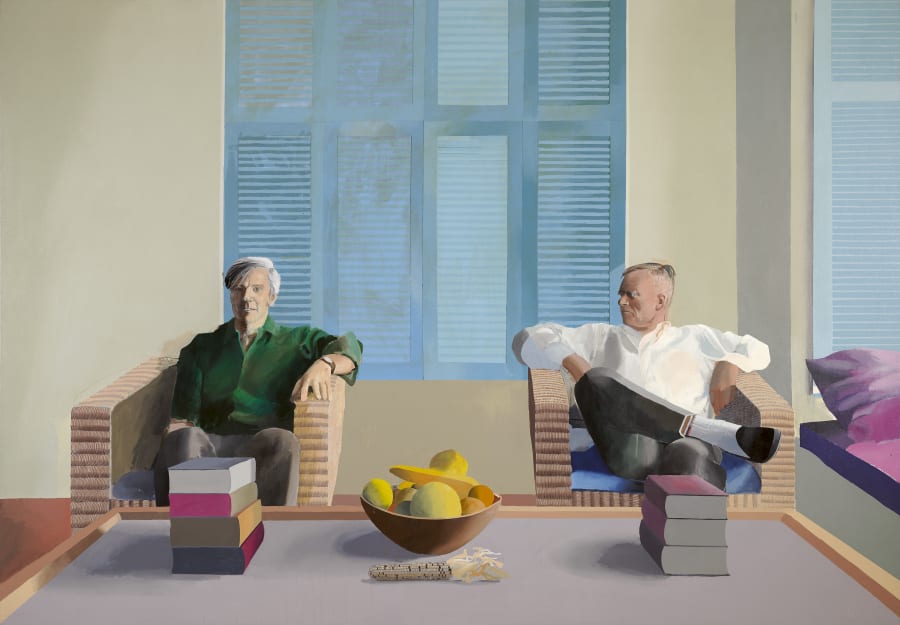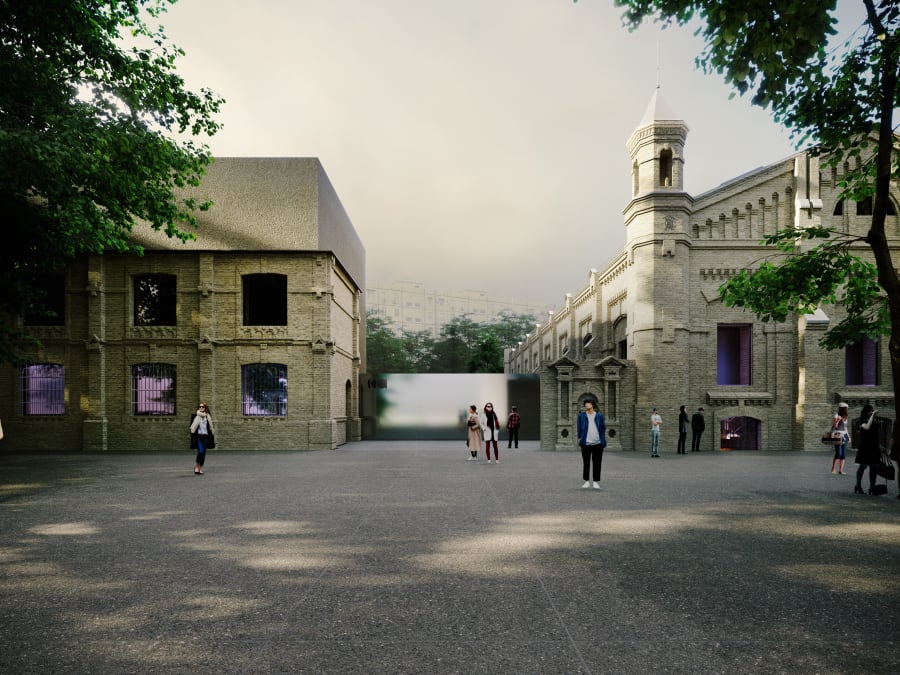Georgia O’Keeffe. Bruce Nauman. Agnes Martin. Judy Chicago. John McCracken. Lynda Benglis. With many of modern and contemporary art history’s most celebrated figures having settled in New Mexico, the state’s reputation as a haven for artists is near mythical. In recent years, Santa Fe and its surrounding region have spawned a new generation of talents, both homegrown and from afar, who are choosing to stay in the Southwest.
‘I believe our souls recognize a place. There’s a way in which a place can receive you, accept you, and want you there – and I really feel that New Mexico likes me,’ says Bosnia-Herzegovina-born painter Maja Ruznic. She left Los Angeles for New Mexico when her now husband, the artist Æmen Ededéen (Joshua Hagler), joined the Roswell Artist-in-Residence Program in 2018 – one of several residencies in the area that have long attracted young artists. They now live in Placitas, a mountain village between Albuquerque and Santa Fe, where they’ve built a joint studio. The change of pace and scenery provided Ruznic with time and inspiration; she notes ‘I intuitively started absorbing the desert palette around me.’ Paradoxically, going off-grid put Ruznic and Ededéen on the art-world map. ‘It was the best thing we could have done for our careers.’
For Ruznic, flourishing is less about gallery density and more about a spiritual connection to the landscape and ancient architecture. ‘There’s plenty of great contemporary art in the big cities,’ she says, ‘Come here to experience something different. That’s the charm of New Mexico.’ The artist counts the Puye Cliff Dwellings (the ruins of an abandoned pueblo in Santa Clara Canyon) among her local must-sees, for example.
Ruznic is one of 71 artists featured in the 12th SITE Santa Fe International, a sprawling city-wide exhibition in which curator Cecilia Alemani also endeavors to showcase ‘something different’ in both the art on view and the exhibition’s framework. Titled ‘Once Within a Time’, it presents more than 350 artworks from 1926 to the present that respond to New Mexico’s distinctive geography, history, and cultures. The exhibition takes its title from the 2022 film by Santa Fe-based experimental filmmaker Godfrey Reggio, who is also included. Alemani was especially inspired by his work’s circular narratives. ‘With Cecilia’s shows, there is this sense of time fully collapsing,’ says Ruznic. ‘The past is the present; the present is the past.’
Formerly known as the SITE Santa Fe Biennial, it relaunched as the International in 1995, making it one of America’s first recurring mega-exhibitions. ‘Once Within a Time’ is the first edition since 2018, and the first since Louis Grachos returned to the acclaimed SITE Santa Fe museum in 2021 as Phillips Executive Director, having previously served as director there from 1996 to 2003. ‘When I rejoined the museum, one of my hopes was that we would find the right person to reinstate the International in a big way,’ says Grachos, who found his ideal partner in Alemani, the Donald R. Mullen, Jr. Director & Chief Curator of High Line Art. After experiencing her 59th Venice Biennale exhibition in 2022, Grachos was impressed by how Alemani ‘drew more from literature than a traditional art historical approach.’
The International now spreads beyond SITE Santa Fe’s building to 13 other venues, ranging from institutions, such as the New Mexico Military Museum and the Museum of International Folk Art on Museum Hill, to shops downtown. ‘Santa Fe is incredibly complex and alive in a way that I’ve never experienced,’ says Alemani, noting the vibrancy of the city’s Indigenous and Hispanic roots. To eschew stereotypes, Alemani opted for a humanistic approach that relied on in-depth research of Santa Fe’s ‘layers of society, culture, and history.’ She identified 27 ‘figures of interest’ – real and fictional, past and present – with ties to New Mexico and whose lives provide context for the artworks.
For example, at SITE Santa Fe, in a compelling section exploring light, energy, spirituality, and mysticism, paintings by Ruznic, Transcendentalists Agnes Pelton and Florence Miller Pierce, and O’Keeffe’s friend and contemporary, Rebecca Salsbury James, among others, are juxtaposed with a metal ‘healing’ rod that belonged to ‘figure of interest’ Francis Schlatter. A French cobbler by trade, Schlatter emigrated in the late 1800s to the Southwest where he became known as a healer. Dubbed a ‘land of enchantment’ by many, New Mexico was considered a mecca for overcoming tuberculosis and other ailments with its high-altitude air.
Another section is dedicated to sexuality, the human body, and the uncanny. Los Angeles-based painter Louise Bonnet’s new corporeal paintings, for example, were inspired by the so-called D. H. Lawrence ‘Forbidden Art’ collection, now in private hands. Already controversial for racy novels like Lady Chatterley’s Lover (1928), Lawrence, who lived briefly in Taos, produced 25 erotic paintings which were notoriously confiscated in London. Nine are on view as part of the International, and are complemented by a 19th-century travel chest that allegedly belonged to another ‘figure of interest’, María Gertrudis Barceló. Known as Doña Tules, she founded a popular Santa Fe gambling den, which was likely also a brothel. She represents the many women who moved to New Mexico during the late 19th and early 20th centuries in search of independence and creative freedom.
One other such woman was the Boston-born anthropologist Mary Cabot Wheelwright, who co-founded Santa Fe’s Wheelwright Museum of the American Indian in 1937 with weaver and ceremonial practitioner Hastiin Klah. For the International, the Wheelwright hosts works by several Native artists, including New York-based Sky Hopinka (Ho-Chunk Nation/Pechanga Band of Luiseño Indians), New Mexico-based Emmi Whitehorse (Diné) and Nora Naranjo Morse (Tewa), and Oklahoma-based Raven Halfmoon (Caddo), who explore the concept of the journey through landscapes, between languages, and across generations. ‘Exhibiting my art near works by Native artists that I studied in school, like T.C. Cannon and Fritz Scholder, whom I consider the greats in my life, is extremely powerful,’ says Halfmoon, whose monumental sculpture, Soku & Nish (Caddo – Sun & Moon) (2022), is situated outside the museum, facing the distant Sun and Moon Mountains.
‘For those of us who live and work here, Cecilia has opened our eyes to interesting ways of looking at our history, context, and community,” says Grachos, noting that Alemani’s multi-venue curation coincides with a wave of newer galleries and project spaces shaking up Santa Fe. Among them are Kouri + Corrao Gallery (Halfmoon’s Santa Fe representation), Pie Projects Contemporary Art, where International artist Daisy Quezada Ureña had her first solo exhibition in 2024, and smoke the moon, which represents International artist Diego Medina, who, like Quezada Ureña, is based in Santa Fe. Other artists living here include Cannupa Hanska Luger, an enrolled member of the Three Affiliated Tribes of Fort Berthold (Mandan, Hidatsa, Arikara) and Lakota; Northern Cheyenne painter and printmaker Jordan Ann Craig; Diné and Xicana conceptual artist Autumn Chacon; and Piikani (Blackfeet) interdisciplinary artist Terran Last Gun.
Also enriching the area are private collections like the Thoma Foundation Art Vault – the Southwest’s only digital art collection open to the public – and the Tia Collection, whose holdings range from Diné weavings to haute couture. The Santa Fe Indian Market, which brings together more than 1,000 Native American artists from over 200 tribes each August, has become a draw for well-known curators. They can glean additional inspiration from galleries just outside Santa Fe, such as The Valley in Taos and Duende Gallery in Galisteo, or from O’Keeffe’s former homes in scenic Abiquiú and Ghost Ranch (only the former is publicly accessible).
The International and New Mexico’s influx of venues also come at a time when Native art is making strides in terms of global recognition. While schools like Santa Fe’s Institute of American Indian Arts have nurtured and celebrated Indigenous artists since 1962, a watershed moment came last year when Jeffrey Gibson became the first Indigenous artist to represent the United States in a solo exhibition – jointly presented by SITE Santa Fe and the Portland Museum of Art – at the Venice Biennale.
In Santa Fe, a key face of Native art, change is certainly in the air. ‘I’m seeing so much growth in how contemporary artists, jewelers, and fashion designers are showcasing evolving ideas of what being Native looks like today,' says Halfmoon, who enjoys Santa Fe’s unique mix of traditional galleries visited during her youth, and experimental spaces bringing diverse perspectives to the region. ‘The way the International is utilizing museum and historic spaces and bringing the whole city together has already shaken up what these institutions can be.’
The 12th SITE Santa Fe International runs until January 12, 2026.
Stephanie Sporn is a New York-based author, specialized in the intersection between art and fashion.
Caption for header image: Santa Fe Village shopping mall. Photograph by Brad Trone, 2025.
Published on July 15, 2025.


